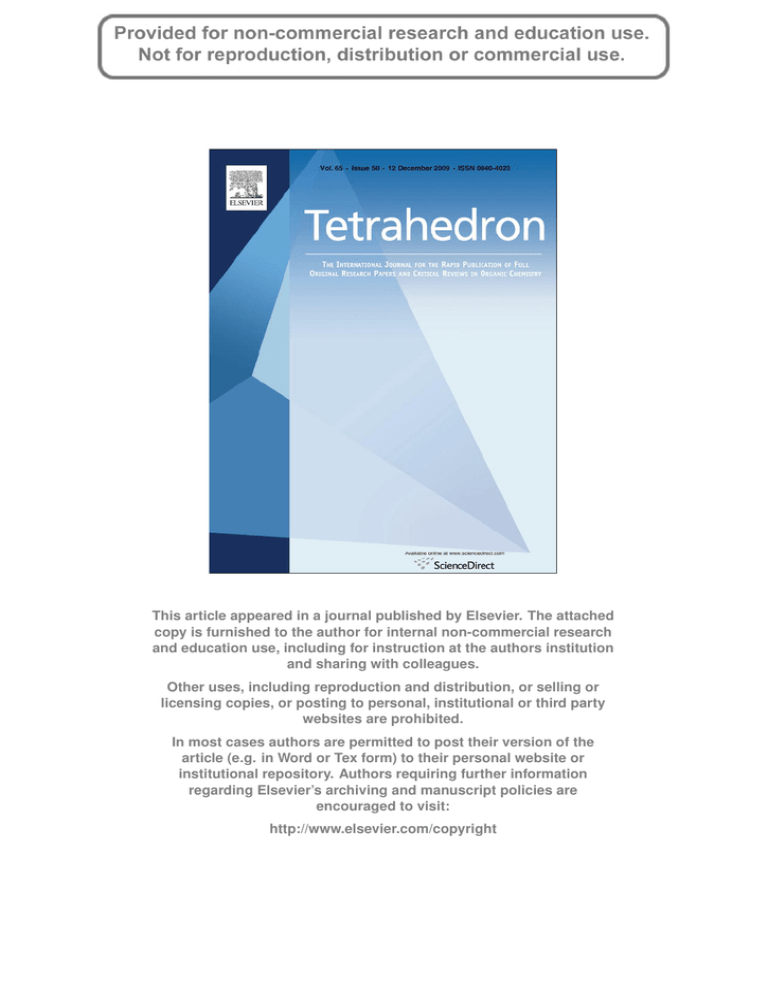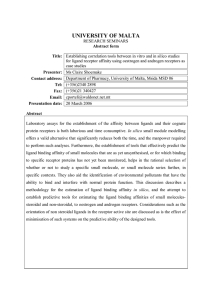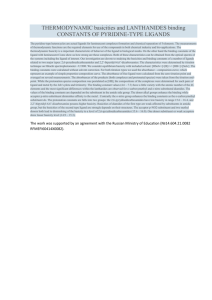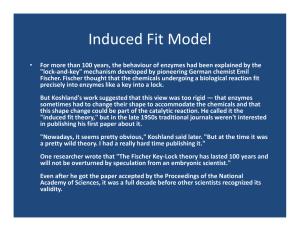
This article appeared in a journal published by Elsevier. The attached
copy is furnished to the author for internal non-commercial research
and education use, including for instruction at the authors institution
and sharing with colleagues.
Other uses, including reproduction and distribution, or selling or
licensing copies, or posting to personal, institutional or third party
websites are prohibited.
In most cases authors are permitted to post their version of the
article (e.g. in Word or Tex form) to their personal website or
institutional repository. Authors requiring further information
regarding Elsevier’s archiving and manuscript policies are
encouraged to visit:
http://www.elsevier.com/copyright
Author's personal copy
Tetrahedron 65 (2009) 10436–10440
Contents lists available at ScienceDirect
Tetrahedron
journal homepage: www.elsevier.com/locate/tet
Dynamic switching between binding sites in the complexation of macrocyclic
‘push–pull’ chromophores to lanthanides
Carmine Coluccini a, Dario Pasini a, *, Pierpaolo Righetti a, b, Douglas A. Vander Griend b, *
a
b
Department of Organic Chemistry, University of Pavia-Viale Taramelli, 10-27100 Pavia, Italy
Department of Chemistry & Biochemistry, Calvin College, Grand Rapids, MI 49546-4403, USA
a r t i c l e i n f o
a b s t r a c t
Article history:
Received 27 April 2009
Received in revised form
22 September 2009
Accepted 8 October 2009
Available online 13 October 2009
The introduction of a 1,3-diacetylpyridine moiety, as an additional binding niche in a macrocyclic receptor ligand containing a conjugated, push–pull malonate functionality, leads to, in addition to the 1:1
binding stoichiometry, the equilibrium formation of multiple complexes, specifically 1:2, 2:1, and 3:1
ligand:metal complexes with lanthanide trications. Various binding modes elicit distinctive responses in
the visible region, which enhance the potential recognition of lanthanide ions. This paper also highlights
the usefulness of a full factor analysis in the elucidation of complex binding phenomena.
Ó 2009 Elsevier Ltd. All rights reserved.
Keywords:
Macrocycles
Lanthanides
Hill equation
‘Push–pull’ chromophores
Factor analysis
Spectrophotometric titration
Sivvu
1. Introduction
There is a great deal of interest in trivalent lanthanide complexes because of their unique optical properties such as line-like
emission spectra and long luminescence lifetimes. These properties
can be exploited in a wide variety of applications from optical
amplification of lasers1 to in vivo luminescence bioassays.2 The
most successful macrocyclic ligands developed in recent years for
these applications with lanthanide cations are based mainly on
polydentate azamacrocycles with chelating carboxylate arms,
which then encapsulate lanthanide ions with very high stability
constants, but little selectivity.3 Other studies have demonstrated
the possibility of complexing lanthanide ions with polydentate ligands such as podands,4 calix[4]arene derivatives,5 or dendrimers.6
These ligands typically avail at least 8–9 hard donor atoms, like O
and N atoms, to fill the first coordination sphere of the ion.
Lanthanide ions are also widely used in organic catalysis, functioning as Lewis acids. Their relatively weak coordination to organic
moieties facilitates high turnover numbers. One of the added values
* Corresponding authors. Tel.: þ39 0382 98 7835; fax: þ39 0382 98 7323 (D.P.);
tel.: þ1 616 526 8729; fax: þ1 616 526 6501 (D.A.V.G.).
E-mail addresses: dario.pasini@unipv.it (D. Pasini), dvg@calvin.edu
(D.A. Vander Griend).
0040-4020/$ – see front matter Ó 2009 Elsevier Ltd. All rights reserved.
doi:10.1016/j.tet.2009.10.024
of the use of lanthanides in this context is the possibility, given their
high coordination number, of simultaneously coordinating both the
reagent (usually bidentate) and a co-catalyst (both bidentate or
tridentate). 1,3-Dicarbonyl units (either as reagents, malonate derivatives, or catalysts in the form of chiral bisoxazolines) and
1,3-pyridinediacetyl units are amongst the most popular organic
moieties used in this context.7
In this paper, we report on the design, synthesis and complexation of a novel macrocyclic architecture, in which both the above
mentioned moieties are embedded into a covalent cyclic skeleton.
2. Results and discussion
We have recently reported that ‘push–pull’ chromophores, built
around conjugated 1,3-dicarbonyl moieties, behaving as soft ligands, are able to form stable complexes in organic solutions with
lanthanides such as Eu3þ, introduced as its triflate salt (Fig. 1).8
More specifically, we have observed the formation of a stable
1:1 Eu(III):ligand complex with compounds 1 and 2 in MeCN solutions. The association constants could be readily ascertained via
spectrophotometric titration as the intramolecular charge transfer
(ICT) band of either ligand redshifts about 100 nm upon complexation with the Eu3þ cation, and clear isosbestic points persist for
the entire range of the titration. The crown ether structure of
Author's personal copy
C. Coluccini et al. / Tetrahedron 65 (2009) 10436–10440
O
O
O
O
O
O
O
O
O
O
O
O
O
O
O
O
O
O
O
O
N
O
O
O
O
N
N
1
O
N
2
O
3
RO
OR
O
OR
Ln3+
O
N
O
RO
N
D-π-A
D-π-A.Ln3+
Figure 1. The compounds used in this study (top), and the mode of binding between
the chromophore and the lanthanide cation (green sphere).
chromophore 2 stabilizes the 1:1 complex with 2 (log Ka¼3.8 M1)
relative to that with 1 (log Ka¼2.6(1) M1)9 presumably as a result
of the additional coordination of one of the polyether oxygen
atoms, likely the one belonging to the diglycolyl moiety.10
We now introduce and compare ligand 3 (obtained from
a Knoevenagel condensation of the corresponding malonate crown
ether,11 Scheme 1). It incorporates a 2,6-pyridinediacetyl moiety as
an additional stabilizing functionality in the binding of lanthanide
ions, while preserving the overall crown ether structure at 22
atoms as in the case of 2.
O
O
O
O
O
O
O
O
O
O
O
N
O
O
O
O
N
N
O
Piperidinium acetate/Δ
O
O
O
O
O
N
Scheme 1. Synthesis of chromophore 3.
Spectrophotometric titration of compound 3 with Eu(OTf)3 in
MeCN solutions showed an increase in the band associated with
the ICT band of the complex (centered at 480 nm, see Fig. 2), and
a decrease in the p–p* band of the free ligand (centered at
377 nm), similarly to what is observed for 1 and 2. However, unlike
10437
the results with compound 2, no clear isosbestic points exist
throughout the titration range. A close inspection reveals at least
two distinct isosbestic points around 400 nm (404 and 414 nm).
The shift in spectral curves from one isosbestic point to the other
appears to be centered around the addition of one equivalent of
Eu(OTf)3 titrant. This clearly indicates the presence of multiple
equilibria in solution resulting from the introduction within the
crown ether structure of a second binding niche for lanthanide
ions.
The lack of isosbestic points that persist throughout the titration
suggests that there are at least two possible complexes between
ligand and metal. Not surprisingly, modeling the titration profile at
480 nm (see Fig. 2, inset) as a 1:1 binding event gave poor results.
The shape of this profile is sigmoidal, which is not only indicative of multiple equilibria, but also generally associated with
positive cooperativity.12–15 Fitting with the Hill equation (see Table
S1) yields a mathematically safisfactory result: a Hill coefficient of
3.2 and a binding constant of log Ka¼4.0. A profile for the reverse
titration of lanthanide with 3 yields a Hill coefficient of 1.2 and
a binding constant of log Ka¼3.5.
Despite the potential merit of the mathematical fit, Ercolani has
revisited several systems previously reported to show positive
cooperativity, and warned about a judgment on cooperativity on
the basis of Scatchard and Hill plots.16 Clearly, given that this system involves a multivalent receptor (the lanthanide cation, which
can coordinate more than one macrocycle), and a multitopic ligand
(macrocycle 3, possessing two different binding sites), the sensibility of the fitting parameters is highly questionable. Titrating 3
with Gd(OTf)3 also gives a sigmoidal titration profile similar to that
observed for Eu(OTf)3, and the same values in terms of binding
constants.17
To better ascertain the species present and the thermodynamic
relationships between them, a set of absorbance data like those
shown in Figure 2 for Eu(OTf)3 titrated with 3 was modeled using
a factor analysis program called Sivvu, which takes into account all
available wavelengths, and can potentially account for any set of
equilibria.18 Indeed, unrestricted factor analysis on the forward titration reveals that there are at least five and not more than seven
absorbing species that contribute to the data.19 The analysis on data
from the reverse titration (ligand into metal) indicates five major
absorbers. These likely include species with metal to ligand ratios of
1:1, 2:1, 1:2, 1:3, and 0:1. To verify this, the dataset for the forward
titration was modeled according to the following equilibria:
EuðOTfÞ3 D3/Euð3ÞðOTfÞ3 log K a1 [ 6:25ð36Þ
1.4
Eu2 ð3ÞðOTfÞ6 D3/2Euð3ÞðOTfÞ3 log K a10 [ 5:45ð02Þ
1.2
Absorbance (cm-1)
1.0
0.0
0.5
1.0
1.5
2.0
2.5
3.0
Euð3ÞðOTfÞ3 D3/Euð3Þ2 ðOTfÞ3 log K a2 [ 5:01ð4Þ
0.8
0.6
Euð3Þ2 ðOTfÞ3 D3/Euð3Þ3 ðOTfÞ3 log K a3 [ 5:07ð6Þ
0.4
This model fitted the data extremely well (though the possibility
of a 2:2 complex cannot be eliminated). The binding constants are
a result of least-squares refinement. The root-mean-square of the
residuals over all of the spectroscopic data points was just 0.0022.
The error values associated with the binding constants were calculated by re-optimizing the model with 19% of the absorbance
data randomly ignored.20 These six (Eu(III) is a minor absorber)
equilibrium-restricted factors account for 99.76% of the data,
whereas six unrestricted factors could account for 99.787%. No
seventh factor could be found that decreased this gap. The dataset
0.2
0.0
250
300
350
400
450
500
550
600
Wavelength (nm)
Figure 2. Spectroscopic data for the titration of macrocycle 3 (5105 M) with
Eu(OTf)3 (0.15104 M). Inset: Absorbance profile at 480 nm as a function of europium
equivalents.
Author's personal copy
10438
C. Coluccini et al. / Tetrahedron 65 (2009) 10436–10440
from the reverse titration was also modeled with these chemical
equilibria and yielded corroborating results (see Fig. S7).
As expected, these binding constants are higher than the values
attained when just 1:1 binding was assumed since the presence of
other species depletes the effective amounts of reactants. It is also
clear that the pyridine moiety is involved in the binding, as convincingly demonstrated by comparison of Ka1 value for ligand 3
with the Ka values obtained for ligands 1 and 2.
Figure 3 shows the evolving concentration values for the species
in solution for the forward and reverse titrations, which demonstrate the extent to which multiple species co-exist in each
solution.
-6
80x10
Eu
L
Eu2L
EuL
EuL2
EuL3
Molarity
60
40
Figure 4. Refined molar absorptivity curves for the five dominant absorbers that were
found to exist in MeCN solutions of Eu(OTf)3 and macrocyle 3.
20
0
0.0
0.5
1.0
1.5
2.0
Metal Equivalents
2.5
3.0
-6
100x10
Molarity
80
60
40
20
0
0.0
0.2
0.4
0.6
0.8
1.0
Ligand Equivalents
1.2
1.4
Figure 3. Concentration profiles for the six absorbers that were found to exist in MeCN
solutions of 3 upon titration with Eu(OTf)3 (top), and in solutions of Eu(OTf)3 uypon
titration with 3 (bottom).
Further confirmation of the role of the pyridine moiety can be
seen in the wavelength dependent color for each of the metal/
ligand complexes, which are simply determined simultaneously
with the optimization of the binding constants without any apriori
knowledge of absorptivity values. Figure 4 shows the calculated
molar absoptivity curves for the five absorbing species. The two
major bands (w380 nm and w475 nm) help distinguish between
the two binding sites of 3 (1,3-diacetylpyridine and p-chromophore). By comparison with the behavior of model compounds 1
and 2, it is evident that coordination at the p-chromophore brings
about the formation of a new band around 475 nm, whereas coordination to the 1,3-diacetylpyridine, as reported in the literature,
does not.21 Thus, coordination of the lanthanide cation by the 1,3diacetylpyridine does not alter the spectrum around 450 nm.
Not surprisingly, the peak intensity for complexes with one, two,
or three ligands per metal increase with ligand equivalents.
Furthermore, these peak absorbances shift monotonically from
472 nm down to 389 nm and finally 378 nm, which is nearly the
peak absorbance for the ligand by itself (377 nm). This observation
suggests that the mode of binding in these three complexes is quite
distinct. Eu(3)3(OTf)3 is likely formed by the coordination of three
pyridine moieties to the metal, leaving the three p-chromophores
electronically unperturbed. This is consistent with lesser steric
demand of the pyridine moieties compared to that of the p-chromophore end of the ligand. By comparison, the absorption around
475 nm for the 1:2, 1:1, and 2:1 complexes indicates that the pchromophore is coordinated directly to the metal. Eu(3)2(OTf)3
appears to have each of its two ligands coordinated in distinct
modes: one through the pyridine moiety that augments the band
below 400 nm, and one through the p-chromophore that leads to
the new band at 475 nm. Eu(3)(OTf)3 presumably has one ligand
coordinated through both ends (a 2:2 complex is also possible),
which is further established with the addition of a second metal
cation to form Eu2(3)(OTf)6 that does not shift the peak positions
significantly as it also involves a ligand coordinated through both
the pyridine moiety and the p-chromophore, but now to two
separate metal cations.
Doing a proper full factor analysis and fitting all wavelengths
makes it clear that the sigmoidal shape of the titration profile at
480 nm is not the result of cooperativity, but rather competition
between two binding sites (and the accompanying difference in
absorption of the resulting complexes) of the macrocyclic scaffold.
The first one, the diacetylpyridine, is spectroscopically silent at this
wavelength, and it is mainly involved in the binding process in the
presence of excess ligand 3; the second one, the p-chromophore,
spectroscopically active at this wavelength, is mainly involved at
higher lanthanide/macrocycle molar ratios.21
In order to corroborate this model, mass spectrometry was carried out on a variety of MeCN solutions of lanthanide in the presence
of ligand 3. With excess ligand present (Fig. 5a), major peaks were
found for [EuL(OTf)2]þ, [EuL2]3þ, and [EuL2(OTf)]2þ; and minor
peaks were found for [EuL(OTf)2]þ, [EuL2(OTf)2]þ, [EuL3]3þ, and
[EuL3(OTf)]2þ. With excess metal present (Fig. 5b), major peaks were
found for [EuL(OTf)]2þ, and [EuL(OTf)2]þ; and minor peaks were
found for [EuL]3þ, [Eu2L(OTf)2]4þ,[Eu2L(OTf)3]3þ, [Eu2L(OTf)5]þ.
Mass spectrometry therefore helps confirm the identify all of
the species that comprise the model of the spectrophotmetric data.
Similar to ligand 2, for which the most abundant species in the gas
phase was [Eu(2)(OTf)2]þ, [Eu(3)(OTf)2]þ is still one of the most
abundant species present in the MS data.8a This suggests that the
first coordination sphere of the europium cation in MeCN consists
of all three triflate counterions, which are bidentate, and ligand in
a tridentate binding mode. The coordination of 2 then involves
a ‘soft’ ligand, the conjugated malonate, and a hard ligand, one of
Author's personal copy
C. Coluccini et al. / Tetrahedron 65 (2009) 10436–10440
10439
were fully characterized via spectrophotometric titration and mass
spectrometry. Upon modification of the ligand 3 structure, and in
particular by realizing covalently bound dimeric macrocycles, it
should be possible to form colored, dynamic, stoichiometryswitchable supramolecular polymers in a lanthanide-driven selfassembly process.25
Ligands with multiple binding modes, especially ones with differing UV/Vis properties (e.g., silent or active at a particular wavelength), can falsely support a hypothesis of cooperative binding. This
study strongly testifies to the usefulness of full factor analysis in the
interpretation of complex binding events. Modeling the full range of
absorbance data with Sivvu allowed for simultaneous thermodynamic and spectroscopic characterization that then even helped to
sort out the competing binding modes of the ligand.
4. Experimental section
4.1. General
All commercially available compounds were used as received.
Lanthanide Triflate salts were stored under nitrogen. THF (Na),
CH2Cl2 (CaH2), and MeCN (CaH2) were dried and distilled before
use. Compounds 1 and 2 were prepared according to literature
procedures.8a Column chromatography was performed on silica gel
(0.040–0.063 mm). FTIR spectra were recorded using a KBr diffuse
reflectance accessories. 1H and 13C NMR spectra were recorded
from solutions in CDCl3 or CD3CN on 200 or 300 MHz instruments
with the solvent residual proton signal as a standard. Mass spectra
were recorded using an Electrospray Ionization instrument LCQ
Decca (Thermofinnigan). Melting points are uncorrected.
Figure 5. Mass spectrometry experiments for mixtures of ligand 3 (L, 0.001 M) and
Eu(OTf)3. A: 0.5 equiv of Eu(OTf)3. B: 3.0 equiv.
the ether oxygens.22 As this dual binding mode is unusual, mass
spectrometric experiments were carried out in MeCN with ligand 2
and equimolar quantities of five Ln(III) triflate salts (Ln¼La, Ce, Eu,
Gd, Yb) in order to ascertain possible marked differences in the
binding mode of the trivalent lanthanides. The experiment confirmed in all cases the presence of a 1:1 complex in which two
triflate counterions are clearly involved in the first coordination
sphere in the gas phase (see Fig. S1).
Interest in lanthanide luminescence owes to their sharp emissive behavior in solution when suitably excited in the UV/Vis region
through an antenna chromophore. The presence of the conjugated
push–pull moiety in 1–3, directly involved in the coordination
sphere of the lanthanide complex suggests they might work as
antenna chromophores. The ligands 1–3 showed very weak emissive behavior in solution upon excitation of the lowest energy p–p*
absorption transition (in all cases with maxima at 380 nm). Upon
addition of Eu(OTf)3, excitation at 380 nm did not result in line-like
emission form the europium ion (Fig. S8).23 A similar, non-emissive
response was obtained by using an excitation wavelength positioned on the absorption band of the 1,3-pyridinediacetyl moieties
(280 nm).24 The dual nature of ligand 3, and the complex speciation
occurring in solution complicates the use of these cyclic chromophores for optimal luminescence behavior.
4.1.1. Compound 3. The corresponding malonate crown ether12
(411 mg,1 mmol), p-dimethylaminobenzaldehyde (150 mg, 1 mmol)
and piperidinium acetate (10 mg) in toluene (50 mL) were heated
under reflux for 24 h with a Dean–Stark apparatus. The solvent
was then removed in vacuo and the product purified by column
chromatography (SiO2; AcOEt/Me2CO: 9/1) to give 3 as a yellow
solid (324 mg, 60%). Mp: 152–154 C (AcOEt). IR (cm1)¼1720
(nc]o), 1704 (nc]o). 1H NMR (CDCl3) d¼8.31 (m, 2H; PyH), 7.98 (t,
1H; PyH), 7.57 (s, 1H; –CH]C–), 7.37 (m, 2H; Ar-H), 6.65 (m, 2H;
Ar-H), 4.6–4.37 (m, 8H; –COOCH2CH2O–), 4.07–3.8 (m, 8H;
–COOCH2CH2O–), 3.05 (s, 6H; –N(CH3)2). 13C NMR (CD3CN)
d¼167.3, 164.9, 164.8, 164.6, 152.3, 148.0, 142.7, 138.5, 131.8, 128.0,
127.9, 119.2, 119.0, 117.3, 111.6, 69.0, 68.8, 68.7, 68.6, 65.3, 64.8, 64.4,
39.2. UV (MeCN): lmax¼378 (35,520), 250 (10,340), 226 (12,280).
MS (EI, relative %)¼565.3 (100) [MþNa]þ, 543.3 (27) [MþH]þ, 542.3
(14) [M]þ. Anal. calcd for C27H30N2O10 C, 59.8%, H, 5.6%, N, 5.2%;
found C, 59.5%, H, 5.8%, N, 5.2%.
Acknowledgements
This work was supported by the University of Pavia, MIUR (PRIN
2004), Fondazione CARIPLO (project ‘Self-Assembled Nanostructured Materials: A Strategy for the Control of Electrooptic
Properties’ 2007–2009), the American Chemical Society Petroleum
Research Fund (DVG), and Research Corporation (DVG). We thank F.
Corana for help in the interpretation of the mass spectrometric
experiments, and G. Gattuso and M. Parisi (University of Messina,
Italy) for useful discussion.
3. Conclusions
Supplementary data
We have reported the construction of a novel chemical architecture, obtained by joining together two very different, yet preorganized, binding moieties, into a single ligand suitable for the
complexation of lanthanide cations. This ligand shows the ability to
form numerous architectures with various stoichiometries, which
General procedure for the determination of the binding constants, additional graphs; additional mass spectrometric analysis.
Supplementary data associated with this article can be found in the
online version, at doi:10.1016/j.tet.2009.10.024.
Author's personal copy
10440
C. Coluccini et al. / Tetrahedron 65 (2009) 10436–10440
References and notes
1. Kuriki, K.; Koike, Y.; Okamoto, Y. Chem. Rev. 2002, 102, 2347–2356.
2. Pandya, S.; Yu, J.; Parker, D. Dalton Trans. 2006, 2757–2766.
3. (a) Aime, S.; Botta, M.; Fasano, M.; Terreno, E. Chem. Soc. Rev. 1998, 27, 19–29;
(b) Bünzli, J.-C. G.; Piguet, C. Chem. Soc. Rev. 2005, 34, 1048–1077.
4. (a) Charbonniere, L. J.; Ziessel, R.; Montalti, M.; Prodi, L.; Zaccheroni, N.;
Boehme, C.; Wipff, G. J. Am. Chem. Soc. 2002, 124, 7779–7788; (b) Kataoka, Y.;
Paul, D.; Miyake, H.; Yaita, T.; Miyoshi, E.; Mori, H.; Tsukamoto, S.; Tatewaki, H.;
Shinoda, S.; Tsukube, H. Chem.dEur. J. 2008, 14, 5258–5266.
5. Wolbers, M. P. O.; van Veggel, F. C. J. M.; Snellink-Ruel, B. H. M.; Hofstraat, J. W.;
Geurts, F. A. J.; Reinhoudt, D. N. J. Am. Chem. Soc. 1997, 119, 138–144.
6. Kawa, M.; Fréchet, J. M. J. Chem. Mater. 1998, 10, 286–296.
7. (a) Desimoni, G.; Faita, G.; Quadrelli, P. Chem. Rev. 2003, 103, 3119–3154; See
also: (b) Leonard, J. P.; Jensen, P.; McCabe, T.; O’Brien, J. E.; Peacock, R. D.;
Kruger, P. E.; Gunnlaugsson, T. J. Am. Chem. Soc. 2007, 129, 10986–10987.
8. (a) Pasini, D.; Righetti, P. P.; Rossi, V. Org. Lett. 2002, 4, 23–26; (b) Garlaschelli, G.;
Messina, I.; Pasini, D.; Righetti, P. P. Eur. J. Org. Chem. 2002, 3385–3392; (c) Pasini,
D.; Righetti, P. P.; Zema, M. Org. Biomol. Chem. 2004, 2, 1764–1769; (d) Coluccini,
C.; Metrangolo, P.; Parachini, M.; Pasini, D.; Resnati, G.; Righetti, P. P. J. Polym. Sci. A
2008, 46, 5202–5213.
9. Both Ka values determined by fitting an absorbance profile at 500 nm for a 1:1
binding model.
10. 1H NMR experiments with 2 and Eu(OTf)3 (from 0.1 to 0.4 equiv, CD3CN) show
the largest observed shift for the CH2 proton resonances belonging to the
OCH2C]O portion of the crown ether.
11. Carano, M.; Corvaja, C.; Garlaschelli, L.; Maggini, M.; Marcaccio, M.; Paolucci,
F.; Pasini, D.; Righetti, P. P.; Sartori, E.; Toffoletti, A. Eur. J. Org. Chem. 2003,
374–384.
12. Connors, K. A. Binding Constants: The Measurement of Molecular Complex
Stability; Wiley: New York, NY, 1987; In order to rule out the possibility of
kinetic delays in complex formation (thus giving apparent sigmoidal behaviour), the absorption measurements have been repeated in some instances after a few hours interval showing no change between the two
measurements.
13. (a) Pérez, E. M.; Sánchez, L.; Fernández, G.; Martı́n, N. J. Am. Chem. Soc. 2006,
128, 7172–7173; (b) Fernández, G.; Sánchez, L.; Pérez, E. M.; Martı́n, N. J. Am.
Chem. Soc. 2008, 130, 10674–10683.
14. Litvinchuk, S.; Bollot, G.; Mareda, J.; Som, A.; Ronan, D.; Shah, M. R.; Perrottet,
P.; Sakai, N.; Matile, S. J. Am. Chem. Soc. 2004, 126, 10067–10075.
15. Byers, L. D. J. Chem. Educ. 1977, 54, 352–354.
16. Ercolani, G. J. Am. Chem. Soc. 2003, 125, 16097–16103; See also: Hamacek, J.;
Piguet, C. J. Phys. Chem. B 2006, 110, 7783–7792.
17. Titration experiments were run (Table S1) using different concentrations of the
lanthanide triflate and/or inverting the species at fixed concentration, giving in
some instances variable results in terms of apparent association constants.
Recent examples have demonstrated how ion pairing can have dramatic effects
on the measurements of apparent binding stabilities at different concentrations; as demonstrated by the mass spectrometric experiments, in this system
the counterions play an active role in the definition of the first coordination
sphere of the cation in the presence of the added ligands. (a) Gasa, T. B.; Spruell,
J. M.; Dichtel, W. R.; Sorensen, T. J.; Philp, D.; Stoddart, J. F.; Kuzmic, P.
Chem.dEur. J. 2009,15,106–116; (b) Pappalardo, S.; Villari, V.; Slovak, S.; Cohen, Y.;
Gattuso, G.; Notti, A.; Pappalardo, A.; Pisagatti, I.; Parisi, M. F. Chem.dEur. J.
2007, 13, 8164–8173.
18. Sivvu; Vander Griend, D. A.; DeVries, M. J.; Calvin College: Grand Rapids, MI,
2005; www.calvin.edu/wdav4/sivvu.
19. Hugus, Z. Z., Jr.; El-Awady, A. A. J. Phys. Chem. 1971, 75, 2954–2957.
20. 10% of the 451 wavelengths and 10% of the 30 solutions.
21. Renaud, F.; Piguet, C.; Bernardinelli, G.; Bunzli, J. C. G.; Hopfgartner, G.
Chem.dEur. J. 1997, 3, 1660–1667.
22. For a review on crown ether complexation of lanthanides and selectivity issues,
see Piguet, C.; Bünzli, J.-C. Chem. Soc. Rev. 1999, 28, 347–358; See also Ref. 3b.
23. Stomeo, F.; Lincheneau, C.; Leonard, J. P.; O’Brien, J. E.; Peacock, R. D.; McCoy, C.
P.; Gunnlaugsson, T. J. Am. Chem. Soc. 2009, 131, 9636–9637.
24. Weak emissive behavior by an Er complex with ligand 3 has been previously
reported. See Meinardi, F.; Colombi, N.; Destri, S.; Porzio, W.; Blumstengel, S.;
Cerminara, M.; Tubino, R. Synth. Met. 2003, 137, 959–960.
25. Marchal, C.; Filinchuk, Y.; Imbert, D.; Bünzli, J.-C. G.; Mazzanti, M. Inorg. Chem.
2007, 46, 6242–6244.







